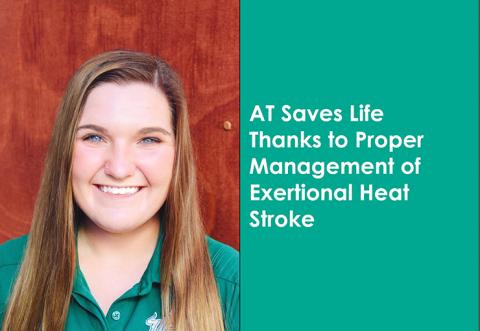
By Rebecca Lopez, PhD, ATC, CSCS, Bryanna Garrett, LAT, ATC, Gianluca Del Rossi, PhD, ATC, and Anna Griffiths, MS, LAT, ATC
University of South Florida, Department of Orthopaedics & Sports Medicine, USF SMART Institute
The proper recognition and management of exertional heat stroke has recently received media attention due to several fatal cases at the high school and collegiate settings. On a warm Friday in Tampa, Florida, this past October, Bryanna Garrett, LAT, ATC, a master’s student in the University of South Florida post-professional program, put her education and training to good use when she properly recognized and managed an exertional heat stroke case while hosting a high school cross country race.
The cross country meet began with the JV girls starting to run at 4:30 p.m. Garrett had an environmental monitoring device set up along the course, and at the start of the race, the heat index was 109.2 degrees Fahrenheit (42.9 degrees Celsius) and the wet bulb globe temperature (WBGT) was 86.5 degrees Fahrenheit (30.0 degrees Celsius). Florida doesn’t have a statewide heat policy that mandates activity modification despite extreme weather conditions. Within the first 30 minutes of the race, Garrett was called to the finish line by a parent whose daughter was exhibiting signs of central nervous system dysfunction (CNS); specifically, confusion, agitation and slurred speech. The athlete also showed other signs of heat illness, specifically diminished sweating, flushed skin, rapid breathing and muscle fatigue.
At this point Garrett sprang into action and put her knowledge of evidence-based medicine to use. Garrett immediately recognized the signs she was observing, explained what was happening to the athlete’s mother, and asked her for permission to obtain the runner’s rectal temperature. The mother insisted that she do what she needed to do. The runner was taken off to the side, where the cold tub was set up and away from the race and spectators, and was draped with a towel to maintain her privacy. The runner’s rectal temperature was 106.9 degrees Fahrenheit (41.6 degrees Celsius). With a temperature above 105 degrees Fahrenheit (40.5 degrees Celsius) and CNS dysfunction present, the diagnosis of exertional heat stroke was clear. Garrett quickly immersed the athlete into a cold-water tub.
Two athletic training students were assisting Garrett that day and aided in activating EMS and recording the rectal temperature every minute during cooling. Although the temperature of the water was not recorded, the cooling rate was approximately 0.41 degrees Fahrenheit per minute (0.25 degrees Celsius per minute), which is the ideal cooling rate for treating exertional heat stroke. While waiting for EMS, Garrett noticed that the athlete was “coming back to life.” EMS arrived and, after being immersed in the cold tub for 15 minutes, the athlete’s temperature had come down to 100.1 degrees Fahrenheit. The athlete was transported to the hospital for intravenous fluids and blood work, but was not admitted. She is now stable and was cleared by a physician to return to running.
Death from exertional heat stroke is preventable with proper recognition and treatment onsite. This case is a clear demonstration of the importance of applying the latest scientific evidence with regard to exertional heat stroke. Garrett had initially learned about the importance of obtaining a rectal temperature to diagnose heat stroke and onsite treatment during her professional education at the University of Lynchburg. These concepts were then reiterated and rehearsed at her new place of employment, the University of South Florida (USF) SMART Institute. The USF SMART Institute provides outreach athletic trainers to several high schools in the area and spends several days/weeks each summer with its staff fine-tuning and rehearsing emergency action plans. Part of this training entails an emphasis on the recognition and treatment of exertional heat stroke.
This incident has once again spotlighted the importance of following best practice guidelines in the treatment of exertional heat stroke, no matter the setting that one works in. Following best practice at the high school level is not only a possibility, but a necessity to ensure young athletes receive the best care. With recent deaths from exertional heat stroke at various settings, it is imperative for athletic trainers in all settings to discuss the prevention, recognition and treatment of exertional heat stroke with supervising physicians, colleagues, emergency personnel and administrators. Having an emergency action plan and heat policy that incorporates the proper methods for recognizing and treating exertional heat stroke is key to avoiding another preventable death from exertional heat stroke.





